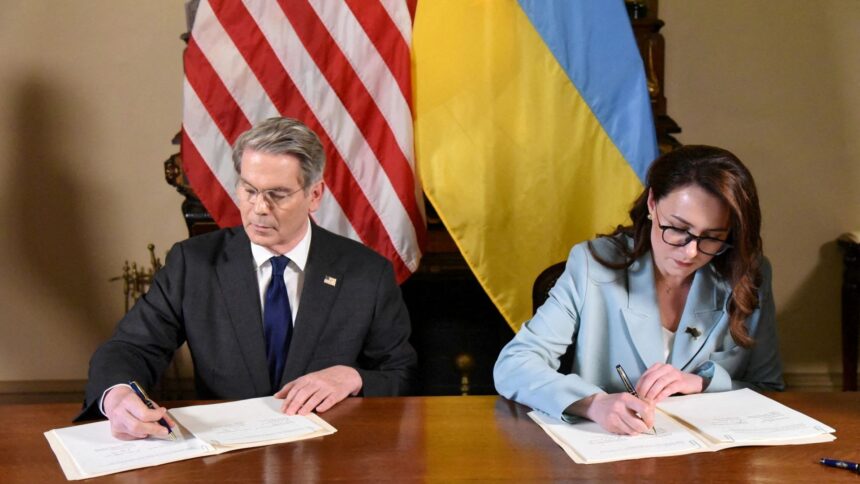On Wednesday, the US and Ukraine reached a significant agreement, marking a new chapter in their economic relationship. The deal, signed at the U.S. Treasury Department, establishes an “economic partnership” that grants the U.S. access to Ukraine’s critical minerals and natural resources. This agreement also creates a “reconstruction investment fund” aimed at supporting Ukraine’s long-term recovery and stability, a key condition insisted upon by President Donald Trump. The deal comes after weeks of tense negotiations and represents a major shift in the way both countries will collaborate moving forward.
The new agreement eliminates a previous U.S. demand for retroactive compensation for more than $100 billion in military aid provided to Ukraine, a term that Ukrainian President Volodymyr Zelenskyy had consistently rejected. However, the deal does include commitments that were initially seen as unattainable for Ukraine, particularly in terms of governance and transparency mechanisms. In return, Ukraine successfully removed provisions that could have complicated its negotiations with the European Union, an issue that had been a major point of contention.
Under the terms of the agreement, Ukraine will retain full control over its natural resources, ensuring that the extraction of critical minerals, oil, and gas remains under its sovereignty. The “reconstruction investment fund” will be jointly managed, with both the U.S. and Ukraine having equal stakes in the projects selected for funding. For the first decade, all profits generated from the fund will be reinvested into Ukraine, strengthening its economy and infrastructure in the process.
A Balanced Partnership Despite Hurdles
While the agreement represents a balanced partnership between the U.S. and Ukraine, it does not offer explicit security guarantees. Instead, future U.S. military assistance to Ukraine, such as contributions to air defense, will be framed as investments under the new economic partnership. This approach has raised questions about the long-term nature of U.S. support, particularly given the ongoing conflict with Russia. As part of the agreement, any future military aid will be linked to economic incentives, creating a new framework for continued support that Kyiv must navigate.
The deal was reached after a tense meeting between President Trump and President Zelenskyy at the Vatican last Saturday. Despite eleventh-hour hurdles that nearly derailed the agreement, both sides ultimately overcame the final sticking points, which related to governance, transparency, and fund traceability. Ukraine’s First Deputy Prime Minister, Yulia Svyrydenko, who signed the deal on behalf of the Ukrainian government, highlighted several key provisions, including Ukraine’s continued control over all resources within its territorial boundaries.
According to Svyrydenko, the agreement outlines an “equal partnership” between the U.S. and Ukraine, with the reconstruction fund structured on a 50/50 basis. The fund will focus on the extraction of critical minerals and energy resources, as well as related infrastructure projects. Ukrainian businesses such as oil and gas producer Ukrnafta and nuclear power company Energoatom will remain in state ownership, a crucial point for Kyiv, which had been concerned about foreign control over its key industries.
Read more: Global Economic Growth Slows Sharply Amid Staggering US Trade War Impact: IMF
Russian Reaction and Global Implications
The deal has not been without its critics. Former Russian President Dmitry Medvedev reacted sharply to the agreement, suggesting that Ukraine had been forced to pay for U.S. military support with its natural resources. Medvedev’s comments, posted on social media app Telegram, accused Ukraine of sacrificing its national wealth for foreign aid, calling it a “disappearing country” in reference to the economic toll of the war with Russia.
Despite such criticism, both Ukraine and the U.S. expressed satisfaction with the agreement. U.S. Treasury Secretary Scott Bessent emphasized that the deal signals Washington’s long-term commitment to supporting a “free, sovereign, and prosperous Ukraine.” He also underscored that the agreement was a key part of efforts to bring an end to the ongoing conflict with Russia, a sentiment echoed by Ukrainian officials.
The agreement is seen as a necessary step in reinforcing Ukraine’s economic foundation while simultaneously addressing the needs of the U.S. to secure access to Ukraine’s valuable natural resources. It has been framed as part of a broader strategy by the Trump administration to facilitate the peace process with Russia while ensuring Ukraine remains a strong, independent nation with the resources necessary for its recovery.
Ukraine’s Path to EU Integration
One of the key concerns for Ukraine was ensuring that the deal did not compromise its sovereignty or disrupt its ambitions for European Union membership. Following significant negotiations, Svyrydenko confirmed that the language of the agreement complies with Ukraine’s constitution and preserves its European integration aspirations. With this assurance, Ukraine can move forward with the agreement without fear of undermining its long-term goals of closer ties with Europe.
The agreement also offers a glimpse into the future of U.S.-Ukraine relations, with a strong emphasis on economic cooperation and the strategic management of natural resources. As both countries continue to navigate the complex geopolitical landscape, this deal could set the stage for deeper ties in the years ahead, with implications not only for Ukraine’s recovery but also for its role in the broader European and global economy.
Follow 10X Times for more business news like this.






